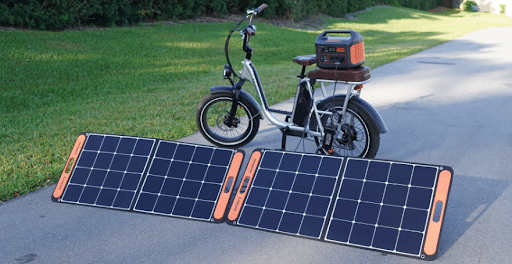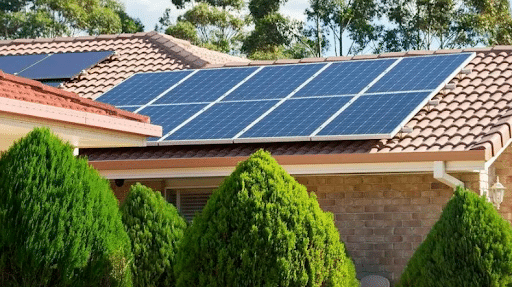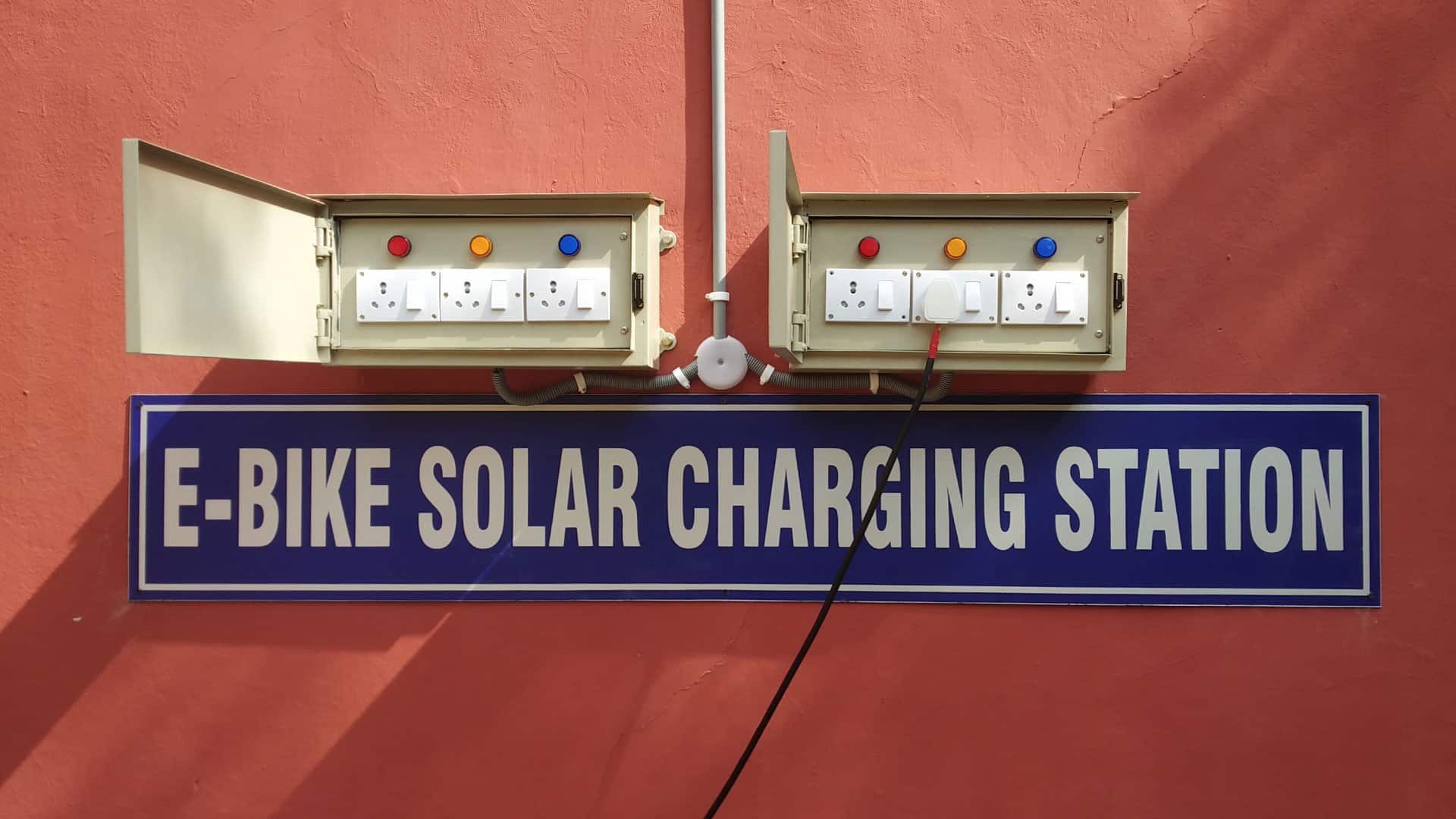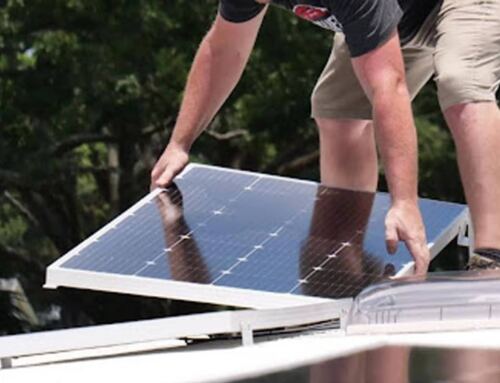Can Electric Bikes Be Charged By Solar?

Guest Blog by Lisa Winget Have you ever wondered if the sun could power your electric bike? Imagine cruising down the street, powered by nothing but sunshine! In a world where renewable energy is becoming increasingly crucial, the idea of charging electric bikes with solar panels isn’t just a dream; it’s a budding reality. As both an e-bike rider and a solar panel enthusiast, you’re uniquely positioned at the crossroads of two exciting technological advancements.
In this article, we’ll explore the possibility of harnessing solar energy to keep our electric bikes rolling. So, buckle up and get ready for a sunny ride into the future of eco-friendly transportation!
Understanding E-Bike Charging:
E-bike charging is key to keeping these modern marvels moving, with the heart of the system being their lithium-ion batteries. These are the same type used in laptops and smartphones, renowned for their efficiency and longevity. Charging an e-bike is usually as simple as plugging it into a standard electrical outlet.
Chris Froome, a cycling expert from Crazy Cyclists, highlights the importance of this process. The charger plays a key role in converting AC to DC power for the battery. Improper charging, like overcharging or undercharging, can significantly shorten a battery’s lifespan, similar to how poor eating habits can impact our health. Froome advises riders to adhere to recommended charging guidelines to keep their e-bike batteries in peak condition.
But what if there’s a twist to this tale? Enter solar charging – an innovative approach leveraging solar technology advancements. This method suggests using the sun’s power, instead of traditional outlets, to charge e-bikes, making the concept of solar-powered e-biking not just a fantasy, but an increasingly feasible reality. Let’s explore this bright idea and its potential to revolutionize e-bike charging.
Solar Charging Options for E-Bikes:

Portable Solar Panels:
Picture this: you’re out and about on your e-bike, far from any plug-in points, and your battery starts to run low. Wouldn’t it be great if you could just whip out a solar panel and start charging? That’s where portable solar panels come into play. These nifty gadgets are like a picnic blanket for the tech-savvy – you unfold them under the sun and let them do their thing.
The basic setup is simple. Most portable solar panels for e-bikes are foldable or rollable, making them easy to carry. You just place them in direct sunlight, connect them to your e-bike battery, and let the sun work its magic. However, not all panels are created equal. When picking one for your e-bike, consider the wattage – it’s like the horsepower of solar panels. Higher wattage means faster charging, but also a bigger, heavier panel. It’s all about finding that sweet spot between power and portability.
Ease of use is another biggie. You don’t want to spend hours trying to set it up, right? Look for panels with simple connections and user-friendly designs. And let’s talk about charging time. This can vary widely based on the panel’s wattage and the battery’s capacity. A small panel might take all day to charge a large battery, while a high-wattage panel could do it in a few hours.
The biggest perk of portable panels? Freedom. They’re perfect for off-grid adventures or those times when you’re away from a power outlet. With a portable panel, the world is your charging station!

Home Solar Power Systems:
Now, let’s shift gears and talk about powering your e-bike at home with solar energy. Imagine your home as a mini power station, with solar panels on the roof charging your e-bike. You can go for a grid-tied system, which is connected to the public power grid, or an off-grid system, which is totally independent. Both have their charms – grid-tied systems let you sell excess power back to the grid, while off-grid systems give you total energy independence.
Integrating an e-bike charger into your home solar system can be as simple as plugging it into a solar-powered outlet. Or you could get fancy with a dedicated setup, designed just for your e-bike.
The potential cost savings and environmental benefits are huge. You’re not just saving on electricity bills; you’re also reducing your carbon footprint. It’s like eating your cake and having it too – you save money and help the planet!
However, it’s not all sunshine and rainbows. Installation costs can be hefty, and your charging is at the mercy of Mother Nature. On cloudy days, your charging might slow down, or you might need to rely on the grid.
In both portable and home solar systems, the future of e-bike charging looks bright – literally. With advancements in solar technology, the dream of a fully solar-powered ride is getting closer every day. So, keep your eyes on the sky; the next big thing in e-bike charging might just be coming from up there!
Advantages and Disadvantages of Solar Charging:
Advantages:
Cost-effectiveness: The sun doesn’t send you a bill! Over time, the cost of solar charging your e-bike can be significantly lower than traditional grid-based charging. Think of it as an investment; while the upfront cost might pinch, the long-term savings are a soothing balm. It’s like planting a tree – you put in the effort now and reap the rewards for years to come.
Environmental Friendliness: By choosing solar, you’re giving Mother Nature a big thumbs up. Solar charging reduces reliance on fossil fuels, slashing your carbon footprint. It’s a small step for you, but a giant leap for environmental stewardship. Imagine cruising around, knowing each pedal helps the planet!
Convenience: Imagine the freedom of charging your e-bike anywhere there’s sunlight. No hunting for outlets or waiting in line at charging stations. Solar panels at home or portable panels for on-the-go charging mean your next power-up could be at a sunny park or in your own backyard.
Energy Independence: With solar charging, you’re the master of your energy destiny. No more being at the mercy of power outages or fluctuating electricity prices. It’s like having your own little power station, providing a sense of self-reliance that’s both empowering and liberating.
Disadvantages:
Initial Investment: Let’s face it, starting a solar charging setup requires a chunk of change. The cost of solar panels and compatible chargers can make your wallet wince. It’s a hurdle, but for many, the long-term benefits outweigh this initial sting.
Weather Dependence: Solar charging is a bit like a weather forecast – it’s not always sunny. The efficiency of your solar charger can dip on cloudy or rainy days, which can be a bummer if you’re counting on a full battery.
Slower Charging Times: Patience is a virtue with solar charging. It’s generally slower compared to plugging into an outlet, which might not jive well with daily, high-mileage riders. It’s like slow-cooking a meal – the results are great, but it takes time.
In the end, solar charging for e-bikes is a bit like a coin with two sides. On one side, there’s the promise of cost savings, environmental benefits, convenience, and energy independence. On the flip side, the challenges of initial costs, weather dependence, slower charging, and storage considerations. But as technology advances, who knows? The disadvantages might just fade like shadows in the bright light of solar innovation.
Conclusion:
In conclusion, solar charging for electric bikes is a glimpse into a sustainable future. It offers an environmentally friendly, cost-effective, and convenient way to power our rides, despite some challenges like initial costs and weather dependence. As technology advances, these obstacles are likely to diminish, making solar-powered e-bikes an increasingly viable and attractive option. Embracing this eco-friendly approach not only benefits individual riders but also contributes to a greener planet.
So, as we pedal into the future, let’s harness the power of the sun to fuel our journeys, both for our benefit and for the environment.

































I’ve been riding a solar ebike as my daily commuter for a year and a half. I just tripped over five thousand miles with it.
My panel is rigidly fixed on my bike so all I have to do is ride and park in the sun. No plugging in, no battery removal. Just ride.
It really is one of the best uses of solar I can imagine. It really changes everything.